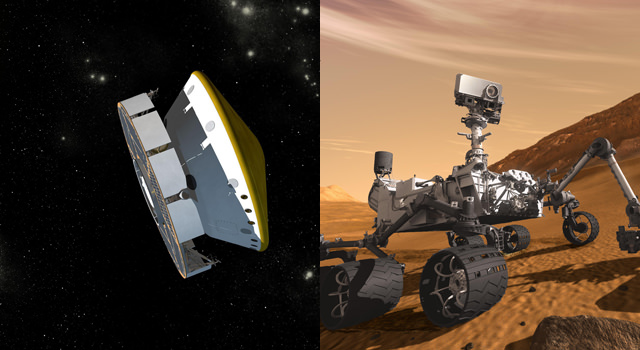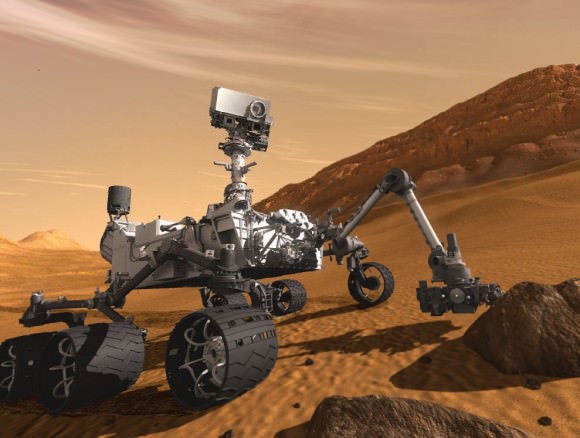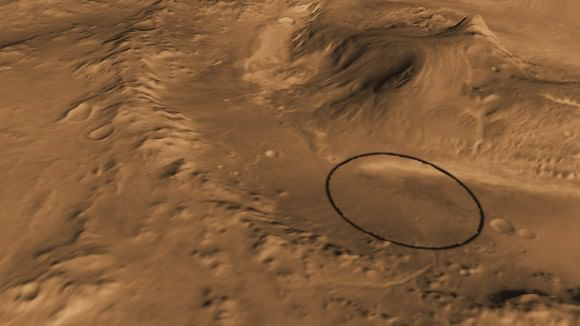Since launching in November 2011, NASA’s Mars Science Laboratory (MSL) has been on a 560 million-kilometer (350 million-mile) journey to the Red Planet, with landing scheduled for late Sunday August 5 or early Monday August 6, depending on where you live on Earth. The Curiosity rover has been tucked away cozily into a spacecraft for safekeeping during flight, but when it reaches Mars’ surface it will encounter tough and frigid conditions, all in the name of science. This is NASA’s fourth rover mission to Mars, and its goal is to determine the planet’s past — and present — potential for habitability. Want to know more? Here are some facts about Curiosity and the mission:
When will it land on Mars?
For us Earthlings, the Curiosity rover will land on Mars at 05:31 UTC on Aug. 6 (10:31 p.m. PDT on Aug. 5, 1:31 a.m. EDT Aug. 6) plus or minus a minute. This is Earth-received time, which includes one-way light time (13.8 minutes) for radio signal to reach Earth from Mars. The landing will be at about 3 p.m. local time at the Mars landing site.
How long does it take for the rover to get to Mars’ surface after it reaches the outer atmosphere?
About 7 minutes. Dubbed the “seven minutes of terror” by NASA, MSL will employ a parachute, landing rockets, a hovering sky crane, and other complicated mechanisms to help lower the rover to the surface of Mars.
Watch this video to learn more about the seven minutes of terror:
How big is the parachute?
The diameter of the parachute is 15 meters (51 feet). It is a supersonic parachute, the largest ever deployed on another world. The parachute can withstand 65,000 lbs of pressure, which is critical, as in the Martian atmosphere, once the parachute deploys, it will still be forced to cope with 9Gs of pressure. It is orange and white (the school colors of Caltech, home of the Jet Propulsion Laboratory)
How big are the spacecraft and the rover?
Cruise vehicle dimensions (cruise stage and aeroshell with rover and descent stage inside): Diameter: 4.5 meters (14 feet, 9 inches); height: 3 meters (9 feet, 8 inches)
Curiosity Rover dimensions: Length: 3 meters (9 feet, 10 inches) — (not counting arm); width: 2.8 meters (9 feet, 1 inch).
Height at top of mast: 2.1 meters (7 feet)
Arm length: 2.1 meters (7 feet). The arm is capable of collecting powdered samples from rocks, scooping soil, preparing and delivering samples for analytic instruments, and brushing surfaces on the planet.
Wheel diameter: 0.5 meter (20 inches)
Mass: 3,893 kilograms (8,463 pounds) total at launch, consisting of 899-kilogram (1,982-pound) rover; 2,401-kilogram (5,293-pound) entry, descent and landing system (aeroshell plus fueled descent stage); and 539-kilogram (1,188-pound) fueled cruise stage.
How does the rover get its power for roving?
Multi-mission radioisotope thermoelectric generator and lithium-ion batteries
What are the science instruments on board Curiosity?
10 instruments weighing a total of 75 kilograms (165 pounds), to do many of the tasks scientists do in a lab. Instead of sending samples back to Earth for humans to analyze, the Curiosity rover will thus be able to do laboratory tests right from the Martian surface. The instruments are:
Alpha Particle X-ray Spectrometer, Chemistry and Camera, Chemistry and Mineralogy, Dynamic Albedo of Neutrons, Mars Descent Imager, Mars Hand Lens Imager, Mast Camera, Radiation Assessment Detector, Rover Environmental Monitoring Station, and Sample Analysis at Mars
How many cameras are on Curiosity?
17 (some of which are part of the 10 science instruments)
When did Curiosity launch?
Nov. 26, 2011, 10:02 a.m. EST, from Launch Complex 41, Cape Canaveral Air Force Station, Fla.
Launch Vehicle: Atlas V 541 provided by United Launch Alliance
How far is Mars away from Earth?
Earth–Mars distance at launch: 204 million kilometers (127 million miles)
Earth–Mars distance on landing day: 248 million kilometers (154 million miles)
Total distance of travel, from Earth to Mars: About 567 kilometers (352 million miles)
How fast can Curiosity rove?
On average, the rover is expected to travel across the surface of Mars at about 30 meters (98 feet) per hour, based on power levels, slippage, steepness of the terrain, visibility, and other variables.
Where is Curiosity’s landing site?
Landing site: 4.6 degrees south latitude, 137.4 degrees east longitude, near base of Mount Sharp inside Gale Crater, a layered mountain that rises 4.8 kilometers (3 miles). The mountain was named after planetary geologist Bob Sharp.
What will the weather be like at Gale Crater?
Expected near-surface atmospheric temperatures at landing site during primary mission: minus 90 C to zero C (minus 130 F to 32 F ). Basically, cold and windy with wind gusts of up to 144 km/h (90 mph) —as strong as some hurricane winds on Earth. Mars is home to dust storms and quickly moving whirlwinds known as dust devils.
How many possible landing sites did scientists considered before deciding on Gale Crater?
60. Gale Crater was chosen because it is thought to contain elements that are important to the search for the ingredients of life.
How long is the primary mission?
One Martian year. Because a day on Mars is longer than one on Earth—39 minutes and 35.244 seconds longer, to be exact—a Martian year is equal to 98 weeks, or 687 days, on Earth.
How much does this mission cost?
$2.5 billion, including $1.8 billion for spacecraft development and science investigations and addition amounts for launch and operations.
Lead image caption: Curiosity completes Biggest Interplanetary Rocket Firing to Mars. Illustrations show (left) the Mars Science Laboratory spacecraft during its voyage from Earth to Mars and (right) the mission’s rover, Curiosity, working on Mars after landing. Credit: NASA/JPL/Caltech
Second image caption: This computer-generated view based on multiple orbital observations shows Mars’ Gale crater as if seen from an aircraft northwest of the crater. Image Credit: NASA/JPL-Caltech/ASU/UA




Since Curiousity is powered by an RTG instead of solar panels, what are the chances of an extended mission? Put another way, is the RTG calibrated for a hard stop at 98 weeks, or is that more of an admin type deadline that could be extended, such as Opportunity, Spirit, Cassini, and many others.
iirc the RTG has enough juice to provide the rover with power for over a decade. I would imagine that the mission will be extended past the projected deadline. It would be a waste to abandon a perfectly good $1.8billion rover on the surface of mars. Especially since NASA wont be sending another for quite some time.
That may not be that easy to answer. Apparently there were some technical issues with the MMRTG subsystem, there’s a short paragraph about it here:
http://thespacereview.com/article/2129/1
Hopefully they got resolved though.
I wrote about it here:
“More to the point, and I didn’t know this, the redevelopment of RTGs, since the old technology had been lost, wasn’t all too successful. Apparently it looses capacity at shocks such as EDL, and the mission has recently and perhaps silently been scaled back in scope. (As of 2011.)
“More Recent Concerns. Project managers stated that the expected performance of the rover’s power generation system, the Multi-Mission Radioisotope Thermoelectric Generator (MMRTG), has been reduced. Thermoelectric modules inside the MMRTG, which was developed and provided to NASA by the Department of Energy, convert heat (thermal energy) from the decay of a radioisotope (plutonium-238 dioxide) into electricity. Project managers attribute some of the MMRTG’s performance degradation to the natural radioactive decay that occurred during the 2-year launch delay. However, unexpected temporary reductions in the system’s power output were also noted during testing that simulated the vibration and shock that MSL will experience during its entry, descent, and landing on Mars.
Department of Energy officials stated that the power degradation issue is unlikely to cause a catastrophic failure. However, as a cautionary measure, MSL Project managers have reduced the mission’s performance capabilities to processing 28 rather than 74 soil and rock samples and to traversing 4.5 kilometers rather than 20 kilometers.”
Curiosity wouldn’t be able to climb that mountain straight up under that regime (5 km ascent)! I assume performance capabilities is under some minimum mission requirements (“cautionary” case), but it isn’t really reassuring. I hope the RTG will survive to make the usual long lived mission profiles that we are getting used to! Already 2 out of the original 14 years of RTG capacity have been lost. :-/
Scientists ideally wants to do one at least 37 km traverse. That is ~ 10 times “the mission’s performance capabilities” in the cautionary case.”
The RTG survived the launch, or MSL would be without power. Still that landing and the nominal 1 year to survive. Anything after that will be a bonus indeed.
Thank you all for those informative answers. Everything you folks wrote reinforces the idea that nothing about this mission is either simple or routine. Aside from the science that will be done, this mission has a huge cool factor. First, the nature of the descent is impressive. The vehicle is going to execute a very complex and precise series of acts, all without realtime human intervention. Hats off to the engineers who are and did make it happen. Then, there will be a nuclear powered, autonomous (largely) automobile operating on another planet; not to mention that it also a state of the art laboratory with everything except white coats walking around it. This is another event for which all of humanity can be proud. To the Curiousity design, launch, flight, and mission teams: thank you.
is the rover going to make revolutions around mars in orbit before descent or is it a one shot deal?
One shot.